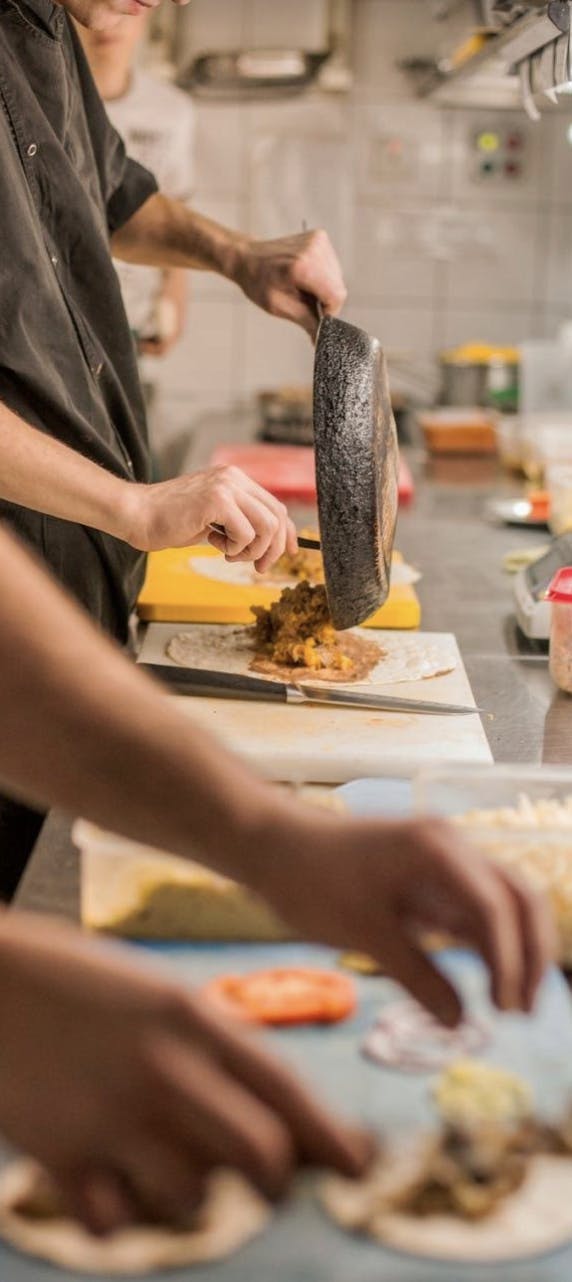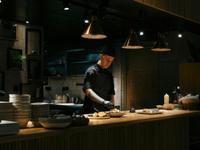How to open a ghost kitchen in NYC: A complete step-by-step guide for food entrepreneurs
Table of Contents
CloudKitchens
How many tacos can be delivered from a 1000sqft restaurant?
The same amount as a 200sqft ghost kitchen.
New York City’s fast-paced, delivery-driven food scene is tailor-made for digital-first restaurant models, and ghost kitchens are at the heart of this revolution.
For restaurateurs, caterers, and food startups, launching a ghost kitchen in NYC offers unrivaled market reach and efficiency, without the risk or overhead of traditional dining.
But opening a ghost kitchen in NYC requires careful planning, regulatory compliance, and the right operational setup.
Why NYC is a prime market for ghost kitchens
NYC is one of the world’s top food delivery cities, with densely packed boroughs, high digital adoption, demanding consumers, and constant appetite for new flavors. The city’s notoriously high rents and labor costs make ghost kitchens a smart and scalable solution for both new and established brands.
NYC delivery volume continues to climb as consumer habits shift in favor of convenience and variety, and established restaurant groups and virtual brands alike use ghost kitchens for expansion and resiliency.
Read more: What are Ghost Kitchens? The definitive guide to Virtual Restaurants
Opening a ghost kitchen in New York City
Before diving into the essential steps for launching a ghost kitchen in NYC, it’s important to understand why methodical preparation is crucial to your long-term success. Opening a delivery-only kitchen is more than just leasing a space and setting up equipment, it involves aligning your operation with legal standards, optimizing efficiency, and laying a foundation for future growth.
The process begins with a clear strategy, comprehensive knowledge of the city’s unique food delivery market, and an understanding of the practical requirements for digital-first dining.
Taking time at the outset to carefully consider each stage will save you from costly missteps down the road. With thoughtful preparation, you’ll set the stage for a smooth launch and a competitive edge in New York’s vibrant food landscape. Check the steps to get started with your ghost kitchen in New York!
Step 1: Secure a commercial kitchen space
The foundation of every NYC ghost kitchen is a licensed, well-located commercial kitchen. This isn’t a home kitchen or a converted backroom, it must be approved for commercial food prep, inspection-ready, and equipped for your production needs.
What to consider:
- Size: Most successful ghost kitchens operate in spaces as small as 200–400 sq ft, but plan for current and near-future output.
- Location: Opt for neighborhoods with high delivery demand—Williamsburg, Midtown, Sunnyside, the Bronx, and Brooklyn hubs are top choices.
- Compliance: Kitchens must meet NYC Department of Health standards for ventilation, equipment, and hygiene.
Read more: Top NYC neighborhoods for growing your food delivery business
Step 2: Obtain proper permits and business licenses
Before you cook a single order, ensure you’re fully licensed. In NYC, you’ll need:
- Business entity registration: Register as an LLC, corporation, or sole proprietorship.
- NYC Food Service Establishment Permit: The commercial kitchen and your operation must be licensed by the NYC Department of Health and Mental Hygiene (DOHMH).
- Employer Identification Number (EIN): For tax and payroll.
- Sales tax registration: With the NY Department of Taxation and Finance.
- Certificate of Authority: For collecting and remitting NY sales tax.
- Workers’ compensation and liability insurance: Required for compliance and protection.
- Other possible certificates: FOG (fat, oil, grease) compliance, depending on cuisine.
Kitchens offered by experienced providers are often pre-inspected and compliant, drastically reducing approval timelines.
Read more: How to easily get your Food Handlers License in NYC: A complete guide
Step 3: Equip your ghost kitchen for high-volume delivery
Ghost kitchens should be highly efficient and suited for specific cuisines and prep styles.
- Core equipment: Commercial ovens, ranges, refrigeration, prep tables, warewashing, safe storage.
- Smallwares: Cutting boards, utensils, food processors, packaging tools.
- Technology: Fast internet, tablets or POS devices, integrated printers.
Before signing any lease, ensure your space supports your planned menu and workflow.
Step 4: Integrate with delivery platforms and set up technology
Make your ghost kitchen visible where customers order:
- Register with major delivery platforms: Uber Eats, DoorDash, Grubhub, and Seamless.
- Consolidate orders: Use order management software to route all tickets to a single interface, minimizing confusion and delays.
- Sync with POS and inventory systems: Track each sale, menu item, and stock for flawless execution.
Read more: Top 5 Food Delivery Apps for Your Restaurant
Step 5: Develop your digital brand, menu, and marketing
With no physical presence, your branding, menu, and online reviews are everything.
- Menu: Curate dishes that travel well and retain quality, focusing on restaurant favorites or niche concepts.
- Packaging: Invest in resistant, insulated containers and branded materials that create a positive delivery experience.
- Online presence: Optimize your brand’s delivery app profiles, build a simple website or landing page, and encourage reviews.
- Promotions: Use app-specific and social media deals to generate buzz and boost first-time orders.
Read more: Tips for proper food delivery packaging: A guide for restaurants
Step 6: Hire and train your kitchen staff
Lean teams are key; often just 4-6 staff members can efficiently operate a ghost kitchen, provided roles are clearly defined and workstations are well organized. Encourage a team mentality, where every member understands the workflow from order receipt to delivery handoff.
- Prioritize cross-training so staff can switch between prep, cooking, and packaging.
- Implement strict protocols for food safety and delivery handoff.
Read more: The ultimate guide to training your kitchen staff for speed and accuracy
Step 7: Open, monitor, and optimize
- Monitor performance: Use analytics to track ticket times, customer reviews, and bestselling items.
- Stay agile: Adjust menus, promotions, and marketing based on customer data and market trends.
- Compliance checks: Schedule regular self-inspections to ensure ongoing health code compliance.
How CloudKitchens accelerates your ghost kitchen in NYC launch
CloudKitchens is at the forefront of helping chefs, entrepreneurs, and restaurant brands open ghost kitchens across New York City. With move-in-ready, fully licensed kitchens in every major delivery hotspot, CloudKitchens saves you months on buildout, assists with compliance and permits, and provides all the infrastructure, premium equipment, tech integrations and so on, you need to operate efficiently.
CloudKitchens’ integrated dashboard lets you manage multiple brands, optimize orders, and access vital performance data in real-time, making scaling within and beyond NYC boroughs simple and cost-effective.
Ready to make your mark with a ghost kitchen NYC? Contact CloudKitchens and launch in the city’s top delivery markets, fast, smooth, and fully supported.
DISCLAIMER: This information is provided for general informational purposes only and the content does not constitute an endorsement. CloudKitchens does not warrant the accuracy or completeness of any information, text, images/graphics, links, or other content contained within the blog content. We recommend that you consult with financial, legal, and business professionals for advice specific to your situation.
More insights & stories
There’s more where that came from.
Get in the know and check out our additional insights



